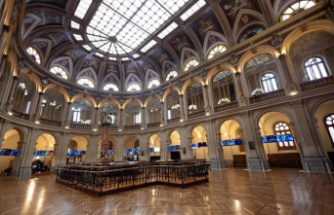The Extremely Large Telescope (ELT), the most powerful optical instrument ever built that will dramatically increase the observation capacity of astronomers, is slowly emerging from the ground in northern Chile, one of the best places to look to the stars.
• Read also: The Gaia space telescope reveals the last secrets of the turbulent Milky Way
• Read also: NASA loses two hurricane monitoring satellites at launch
• Read also: The James Webb Space Telescope suffered a micrometeorite impact
This new "eye on the sky", which will be added from 2027 to the powerful observation instruments already in service in the Atacama Desert, will make it possible to multiply by 5,000 the current observation capacity, and to point the a look at hitherto unknown places to answer questions still open about the origins of the Universe.
"There are certain scientific questions that we would like to answer and these questions lead to the need for technology that helps us answer them," Chilean astronomer Luis Chavarria, from the European Southern Observatory (ESO), told AFP. which finances the construction of the ELT.
“Astronomy always works at the edge of technology, at the edge of detection, at the edge of all that these wonderful instruments can provide,” he says.
Current observing instruments, such as the Very Large Telescope (VLT) - the most powerful instrument currently in operation - and ALMA, the largest radio telescope in the world, both located in northern Chile, are capable to answer the questions that scientists were asking themselves three decades ago.
But the limits of knowledge have been pushed back, forcing the construction of even more efficient instruments, such as the ELT, which will be installed at an altitude of more than 3000 meters on the hill of Armazones, about twenty kilometers from the VLT , owned by ESO in the middle of the desert.
The ELT, whose construction began in 2017, will consist of a primary mirror 39 meters in diameter, made up of 798 small hexagonal mirrors. It will be housed in a huge hemispherical dome 85 meters in diameter that will culminate 74 meters above the ground. Two rounded doors will open laterally to allow observations at night.
"It's a huge technological feat to be able to have the levels of precision necessary to be able to use these telescopes to the maximum (...), something that pushes back the barriers of technology", enthuses Luis Chavarria.
"15 times sharper images"
The construction cost of the huge 2800 ton set is estimated at 1.3 billion euros.
The phase of “major civil engineering works” is currently 40% complete, with the construction of the surrounding wall supporting the dome which will support the mirror panel.
"The ELT is the evolution of the VLT (...) Obviously it's a completely different scale to anything that's been done before, so it has very different (technological) requirements," hence the time required for the work, Guido Veccia, site manager, told AFP.
The current optical telescopes, with a diameter of 8 to 10 meters, have above all enabled scientists to discover exoplanets, these planets in orbit around other stars where the search for traces of life is concentrated.
But to deepen their knowledge, more precise, and therefore larger, observation instruments are needed, capable of collecting a greater quantity of light.
With its diameter of 39 meters, the ELT "will collect 15 times more light than optical telescopes in operation today and will provide images 15 times sharper than those of the Hubble Space Telescope", according to ESO, the Intergovernmental Organization for astronomy in Europe, funded annually to the tune of 198 million euros by 16 European member countries.
"It's a project for the future that will allow us to reach other distances in the Universe," says Susy Solis, geologist and technical assistant for the construction of the ELT.
The climatic characteristics of the Atacama Desert and its arid weather, which allow observations in a perfectly clear sky a very high proportion (90%) of nights of the year, make it a particularly favorable place for astronomical observations.
One of its ultimate goals will be, according to ESO, to have images “of rocky exoplanets to characterize their atmospheres and directly measure the acceleration of the expansion of the Universe”.













